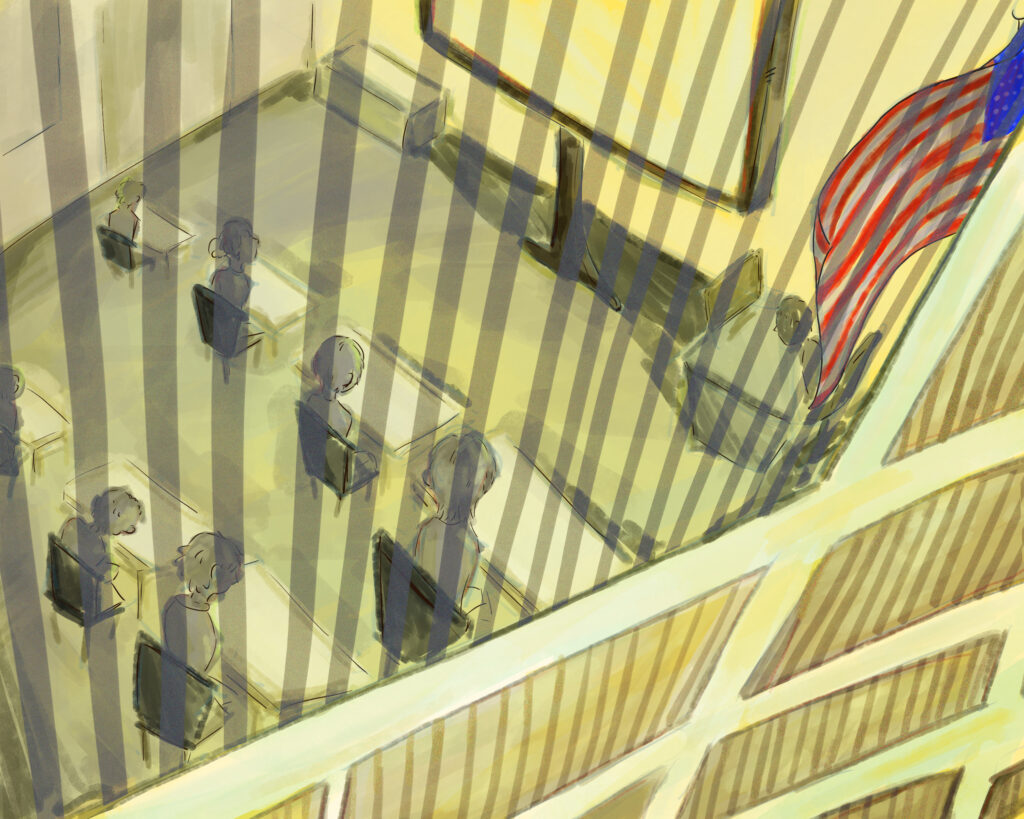Alara Göksu is Lead Opinion Editor at The Black & White newspaper of Walt Whitman High School in Bethesda, MD.
It’s no secret that the Republican Party and former president Donald Trump have a tough-on-crime stance, while the left has generally leaned towards prison reformation and even abolition. Before Kamala Harris stepped into the spotlight as the Democrats’ presidential nominee, the party’s stance on the American prison and incarceration system was clear: they’ve affirmed time and time again that their ultimate goal is to “overhaul the criminal justice system from top to bottom.”

However, as the former Attorney General of California, Harris has long been criticized for her role in the wave of mass incarceration in the early 2000s, and notably for her involvement in pushing mandatory minimum sentencing, a policy that disproportionately impacts black and brown Americans convicted of nonviolent offenses.
Mandatory minimums are byproducts of sentencing laws that mandate a certain number of years to be served for a crime, regardless of special circumstances or lack of criminal history. Lawmakers first passed these sentencing laws during Nixon’s War on Drugs, when paranoia around heightened drug use bred a government so frightened of narcotics they were willing to sentence an offender who possessed less than nine ounces of marijuana to 40 years behind bars. In the modern day, prosecutors often use plea deals to get individuals sentenced without a trial. If an offender chooses to reject the plea and go to trial, the justice system, drowning in caseloads, makes them wait years for a trial date before slapping them with a mandatory minimum sentence that locks them away for four, five, or even six times the amount of time they would have gotten with the plea.
As she takes the helm as the Democrats’ leader, Harris must be prepared to fend off attacks from her opposition about her seemingly rocky past in the criminal justice system. Considering the history of incarceration in the United States, it is important now more than ever that the Democratic Party clean up their stance on prison reform and make their position on the past, present, and future clear to voters.
Prisons began popping up in the United States at the turn of the 19th century with the initial purpose of doling out general punishments to deter crime. Early prisons operated without distinction between types of crime — but after less than a century, they began to shift their goals. Old fears about controlling children turned into new proposals, and criminality became synonymous with unruliness. If something were not done to fix the mind of the young criminal, lawmakers argued, it would jeopardize the future of the country. Under this impression, prisons transitioned into centers of social rehabilitation, and imprisonment served to take over from where society had failed in properly raising those who turned to crime and, within the time of their incarceration, produce individuals who would reenter society worthy and able to contribute to their communities.
While originally simple brick-and-mortar buildings with the goal of reshaping the mind, the prison soon became a conceptual institution and has been continually mirrored in other aspects of American society — namely the public school, the factory, and the psychiatric facility. Though moderating now, the disciplinary freedoms granted to those in running each institution, from teachers to nurses, have long aligned with those granted to correction officers.
THE PUBLIC SCHOOL
In the United States, education is compulsory for all children. While state governments have the general autonomy to decide the age at which individuals can stop attending school, the nationally accepted standard is that students must remain in school until the age of 16. Certain religious exemptions have been made (see Wisconsin v Yoder), but in general, it is a nationally recognized directive that for an average of 179 days over a 10-month period, roughly 54 million students K-12 attend school for at least five hours daily. Over 13 years, that amounts to 11,635 hours spent within the walls of a school building during a period of time critical for social and emotional growth. It is important, for that reason, that there is an emphasis on how these students are treated—for the way they are shaped during those years will reflect the trajectory of their lives after they leave.
With the federal government’s long history of keeping American citizens under rigid control, it should come as no surprise that even within the education system, there are rights afforded to teachers to ensure that they keep order within their classrooms. The 1977 Supreme Court ruling in Ingraham v. Wright affirmed the right of schools to have corporal punishment policies regarding how they dealt with in-school misbehavior. A comprehensive study of the use of corporal punishment in US public schools by the NIH found that, as of 2018, corporal punishment was legal in 19 states and affected the lives of nearly 200,000 students for the 13-year period in which they completed their education. The legality of corporal punishment is concentrated mainly in the American South and disproportionately impacts students of color, students who are boys, and students with disabilities.
Unsurprisingly, those three demographics are disproportionately represented in the US prison population as well. The study also found that despite white children attending schools that permitted corporal punishment at higher rates, black children still were the victims of corporal punishment at rates far higher than that of their white counterparts.
School corporal punishment — as defined by Texas, one of the states that permits it — is the “deliberate infliction of physical pain by hitting, paddling, spanking, slapping, or any other physical force used as a means of discipline.” Made constitutionally permissible by the highest court in the land, corporal punishment allows educators to take their anger out on schoolchildren virtually unchecked, as long as they can justify that the student behaved unacceptably. However, the idea of bad behavior is incredibly subjective; in North Carolina, cell phone use in class constitutes bad behavior and therefore warrants corporal punishment.
While the psychological effects of corporal punishment can be debated, it is a fact that the ghost of in-school violence follows students into their adult lives. The term “school-to-prison pipeline” refers to an observed national trend in which students who are subjected to corporal punishment, attend school under the watch of police officers, and are threatened with “zero tolerance” policies in public schools have a higher likelihood of being incarcerated, and at a quicker rate post-graduation, than those who experience school under opposite circumstances. The pipeline is most often reflected in the lives of individuals who are Black, men, or have a disability, once again mirroring the demographics of the national prison population.
Not only do American public schools often mirror prison in the way they are set up and operated, but they prime youth for a life behind bars subsequent to their departure from the education system. If a prison-like environment is all children know for 11,635 hours of the most critical years in their development, can it really be deemed a coincidence that they are funneled so quickly after they leave that oppressive institution into the next, and one that will keep them in that same environment for an average of 90 months?
THE FACTORY
The prison boom of the early 1800s was in part due to the Jacksonian fear that society was moving in an unfavorable direction and that the disorder experienced in small-town America would soon spread around the country, destroying the positive trajectory that President Andrew Jackson’s election win had set the country on. Thus, those who held this fear scrambled to create an institution that would bring order back to the general public. Two of the earliest modern prisons, Auburn Prison in New York and Eastern State Penitentiary in Pennsylvania, kept inmates in solitary confinement and encouraged an individualistic lifestyle that would promote self-improvement and a sense of purpose. Incarcerated individuals at these prisons would eat, sleep, and work without speaking a word to each other, and in the case of Eastern State, without even seeing each other. To those on the outside, the prisons seemed to be working. Not only were criminals being put away with the intention that they would come back better versions of themselves, but the prisons ran without difficulty or pushback from the incarcerated. For the most part, the general public perceived that the systematic incarceration of those deemed unfit to continue living in society was working well. It is unsurprising, considering the victory of incarceration, that the country soon looked to apply the prison concept to different national institutions.
The increase of prisons being built around the country coincided with the Industrial Revolution, and as a result, the early factory and prison had a lot in common. The lower class were ushered into the factories by the thousands, and worked under precarious conditions for long hours and little pay. However, it wasn’t so much the physical environment they worked in that resembled prison, but the mental one. They were assigned specific tasks for definite amounts of time, patrolled strictly, and permitted to eat and drink only at designated meal times. They were awarded for hard work with pay raises, and in the case of many child laborers, punished harshly if they did not work hard enough. As David J. Rothman points out in his book Perfecting the Prison, the lower class only really had two options in life: to work in relative freedom or to work in certain captivity.
As a result, the prison loomed as a threatening shadow in the lives of the working immigrant or lower-class individual to remind them what would happen if they didn’t obey societal rules, ensure that the working class would stay working, and provide constant labor to the many factories that required cheap labor, else they be subjected to imprisonment.
THE PSYCHIATRIC FACILITY
The earliest psychiatric facility was created in 1752 by Quakers in Philadelphia. A little over a century later in 1890, care centers for the mentally ill were commonplace in every state across the country. In the meantime, across the Atlantic, in 1843, a legal test known as the M’Naghten Rule to determine criminal insanity was instituted in Britain’s House of Lords.
As mental illness amongst Americans became acknowledged as an accepted medical condition rather than an affliction causing fear, there came to be a new era of criminally prosecuting mentally ill individuals. The “insanity plea,” as it is called in the United States, eliminated criminal culpability for crimes and, if accepted in a court of law, sentenced individuals to stays in psychiatric facilities rather than prison.
However, both early and modern-day psychiatric facilities did not by rule serve to rehabilitate individuals, only to incarcerate them. An especially jarring and recent example of this is the case of Ketema Ross, a Yale Law School alumni who suffered a schizophrenic episode in 2007 and assaulted his two elderly neighbors, thinking that he had instructions from the government to do so. Ross pled not guilty by reason of insanity (NGRI) and was sentenced to care in a state psychiatric facility. Put on medication and receiving the help he needed without outside stimuli, Ross regained mental stability during his incarceration and, after submitting many appeals to be released, was freed after 7 years. The subsequent case he filed against the state of Washington, Ross v. Inslee, brought to light the horrible conditions under which people in the facility lived. Even gradual, supervised rehabilitation prescribed off-premises required written allowance from a state court, and discharge requests were reviewed by a “public safety review panel” in which there were more police officers than mental health professionals. Even though Ross had been stable for many years, he had lived in a state of nearly solitary confinement with no contact to the outside world, he said.
The reality of the situation was that despite Ross having recovered, the government had no intention of letting him reintegrate into society. He was placed in the facility and essentially discarded with no thought to his improving mental state or the benefits he could have to society.
The issue with Ross’ story, as well as those of thousands of other patients who are trapped in psychiatric facilities, is that they are placed there under the pretense that they will one day be allowed to leave, and then continually denied that right. Ross could have easily remained in the facility for the rest of his life, in which case society would have been deprived of an intelligent mind and a skilled criminal justice lawyer. Not only did his case shed light on an incredibly disturbing trend of locking people up instead of helping them in the United States, but it also displayed how even an institution dedicated to helping one of the most vulnerable populations in society has taken the form of prison, and at least in part works to keep the incarcerated, incarcerated.
_____________
The truth is that the United States would not be able to function without mass incarceration. An entire country that profits off of the abuse and unpaid labor of millions of incarcerated individuals will never be able to step away from the system for the simple reason that the loss of profit would be too much to deal with. This is not only regarding the estimated $74 billion in revenue that prisons yield yearly, but also the agricultural, mechanical, and physical labor performed by inmates that contributes to the material growth of the country as well.
While the similarities between the three different institutions examined and prison are undeniable, a bigger question looms as to why exactly the prison has been able to establish itself as an omnipresent force in society. It is certainly not because the prison system in the United States has made any great leaps in crime prevention or safety; in fact, American mass incarceration, continuously reinforced by the ever-looming existence of hundreds of prisons across the country, has been long-condemned as one of the worst examples of concentrated human rights violations in the world.
The answer may lay in the understanding not of prison as a place where criminals are put away, but as a place where laborers are bred, and as a concept, the government utilizes to keep people under control. It has much less to do with national safety than it does with the national economy, and in the case of the three other institutions examined, the guarantee that individuals will be kept in check.
The factory and the public school emerged with and as byproducts of prison facilities to threaten the public into submission, while the psychiatric institution solidified the fact that the United States would rather lock an individual away and forget about them than rehabilitate them. This combination of a lack of interest in rehabilitation and an intense interest in generating revenue has created the system that we see around the country today. Individuals labor for extended periods, leave prison unfit to rejoin society — as demonstrated by the unbelievable 82% national recidivism and re-arrest rate — and then are systematically funneled back into the system they spent years trying to leave. Those on the “outside” are primed to either become dedicated laborers in a free society or cash cows in prison; the reality is that in the United States, you either successfully escape incarceration or successfully fall victim to it. Incarceration isn’t chance, it is a carefully curated lottery in which any outcome is a win for the government. While the lawmakers responsible for these policies would have preferred people be useful contributors to the environment around them by obeying societal rules and expectations, they have no qualms about locking them away.
The reason the prison system has been allowed to continue as it has for so many decades is because it operates under a carefully protected shroud of secrecy; most people don’t realize that on a conceptual level, prison has been instituted in almost every social program in the country. As activist and author Angela Davis put very powerfully in her book Are Prisons Obsolete? “the prison is present in our lives and, at the same time, it is absent from our lives.” Understanding and recognizing how prison has invaded the life of every single American is the first step in the disassembling of the most oppressive institution in the world.



